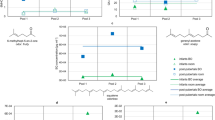Abstract
This study is part of an extensive research program on pheromones aiming to analyze in depth and on a wide scale man's olfaction and its ability to distinguish pheromone-like substances either of male and female origin, as well as the evolution of such ability at different physiological stages during his life. Olfaction tests were conducted on a group of 1318 school children (aged 6 to 14) by mean of “Biologically relevant” substances. Younger males and females showed the same responses to Pirroline Isovalerianate Butyrate and to Androstandiol in an high percentage of cases. Response variability gradually increases with aging and this could be explained assuming that sensitivity to biological smells keeps up with their emission or, even more, with hormone development which originates them. Hormone research is currently being carried on in order to prove such assumption.
Similar content being viewed by others
References
Broca P., 1988. Mémoires d'Anthropologie. Vol. 5 Reinwald, Paris.
Cain W.S., 1974. Contribution of the trigeminal nerve to perceived odor magnitude. Ann. N. Y. Acad. Sci., 237:28–34
Davis R.G., 1973. Olfactory psychophysical parameters in man, rat, dog and pigeon. J. Comp. Physiol. Psychol., 85:221–232.
Doty R.L., 1981. Olfactory communication in humans. Chem. Senses, 6:351–376.
Keverne E.B., 1980. Olfaction in behaviour of non-human primates. Symp. Zool. Soc. London, 45:313–327.
Keverne E.B., 1983. Chemical communication in primate reproduction. In: Pheromones and Reproduction in Mammals (J.G. Vandenberg, ed.): 79–92. Academic Press. New York.
Ligabue Stricker F. and Tua N., 1991. Indagine sulle capacità olfattive e l'odore personale di un campione di bambini di età prescolare. Atti IX Congresso Antropol. Ital. (in press).
Marshall D.A. and Moulton D.G., 1981. Olfactory sensitivity to a-ionone in humans and dogs. Chem. Senses, 6: 53–61.
Powell T.P., Cowan W.M. and Raisman G., 1965. The central olfactory connections. J. Anat., 99: 791–813.
Rees J. and Shuster S., 1981. Pubertal induction of sweat gland activity. Clin. Sci., 60: 689–692.
Schaal B. and Porter R.H., 1991. “Microsmatic Humans” Revisited: The Generation and Perception of Chemical Signals. Adv. Study Behav.
Schleidt M. and Hold B., 1982. Human odour and identity. In: Olfaction and Endocrine Regulation (W. Breipohl. ed.): 181–194. IRL Press, London.
Stoddart D.M., 1988. Human odor culture: a zoological perspective. In: Perfumery: The Psychology and Biology of Fragrance (S. Van Toller and G.H. Dodd, eds): 3–17, Chapman & Hall, London.
Author information
Authors and Affiliations
Rights and permissions
About this article
Cite this article
Ligabue Stricker, F., Chiarelli, B. Research on olfactory perception of biologically relevant substances in a sample of school-children, aged from 6 to 14 years. Int. J. Anthropol. 7, 67–72 (1992). https://doi.org/10.1007/BF02447871
Issue Date:
DOI: https://doi.org/10.1007/BF02447871




